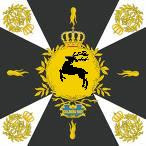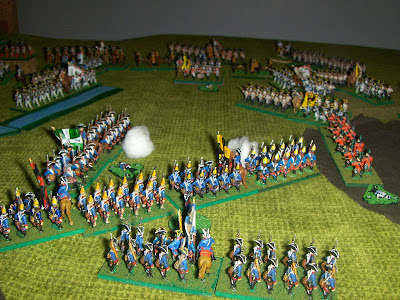
The major Strathian offensive of the war, as the Duke invades Meldenia. Above, we see Strathia entering from the right, while Meldenia approaches from the left - both armies are following the course of the river towards a plateau of raised ground.

The Meldanian Army, led by the Duke Cristoph Von Melden, in a succession of lines thanks to the cramping effect of the river.

The Strathian Army, mostly entering on the same bank...

... and across the river, a small mixed-arms detachment. Its aim is to place cannon over the river on the Meldenian flank, enfilading the line.

The approach - the Meldenians gain the hill, and the Strathians advance. Cannon-shots are exchanged along the main battle-line. The village and the bridge over the river fall to the Strathians, and the cross-river detachment swiftly clears some fields of lurking Meldenian Croats.

The Strathian Duke then sends his guards and grenadiers to his right flank, seeking a double-flanking move. The Meldenian line, luckily heavily stocked with infantry, responds by pulling in both flanks. Will the promised contingent from Meldania's ally, Buvalia, get here in time?

They do! Rushing up at speed from the Meldenian Rear, the Buvalian force moves down the river and detects a previously unnoticed crossing-ford. Suddenly the Strathian flanking cannon are looking vulnerable.

The carefully-tended fields, recently swept of Croats, turn into a close-fought battlefield as Strathian infantry battle to contain Buvalian horse and foot at the crossing.

Back at the main battle-line, the Strathian line is becoming stretched as the Meldenian artillery punches holes through the blue line. Reserves have blocked the flanking attack, so the Duke of Strathia throws in his last reserve in: four brigades of cavalry, launched like a fist into the centre of the Meldenian line to smash it wide open.

Meldenia holds out! The white line holds firm, and the oncoming horsemen are shot down by the score as they advance up the slope, raked by musket volleys and canister from the supporting cannons. The overstretched Strathian army can take no more and begins to fall back, leaving behind some of the flower of its troops dead on the ground

"Your Grace, you must flee this accursed field!"

















